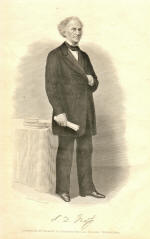Samuel David Gross, M.D.
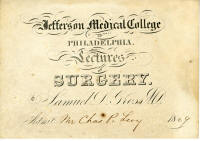
Click on images to enlarge
View the lecture card display
There are
multiple medical books in this collection by Dr. Gross.
Please use Search
The Gross Clinic, 1875 / By Thomas Eakins.
Credit: National Library of Medicine
An 1828 graduate of Jefferson Medical
College, Samuel D. Gross (1805-1884) served as Professor of Surgery at
Jefferson from 1856-1882. Considered one of the finest surgeons of his time,
Gross was the first alumnus to be appointed to a professorship at Jefferson.
After serving on Jefferson's faculty for twenty-five years Gross resigned in
March of 1882. He retained the title of Emeritus Professor of Surgery until
his death on 6 May 1884 in Philadelphia
The 1861 edition of: 'A manual of field surgery by
Gross' is available on line at:
http://jdc.jefferson.edu/milsurgusa/
From the title page: A manual of military surgery; or, hints on the
emergencies of field, camp and hospital practice. Illustrated with
wood-cuts. By S.D. Gross, M.D. Professor of Surgery in the Jefferson Medical
College of Philadelphia. Philadelphia: J.B. Lippincott & Co., 1861.
The 1861 edition is reproduced in two formats for the Jefferson
Digital Commons. A large PDF file offers a faithful reproduction of
the full volume. For greater ease of use, each chapter and plate
grouping is also listed separately.
The above book is needed for this collection.
Additional discussion and
details about: A Manual of Military
Surgery, (1861) by Samuel D. Gross, M.D. from Rutkow: History of Medicine,
p. 41
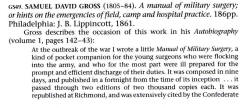
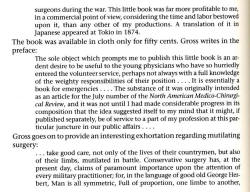

In this collection is the 1866 4th edition of Gross's System of
Surgery, Vol. I & II , which contains all the updates during the
Civil War from the original version in 1859. These two books
were from the 1869 Jefferson Medical School Library collection and
have the School's label (shown below from the inside cover) attached
in the book.
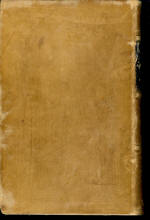

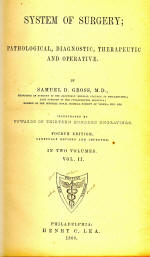
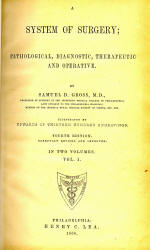
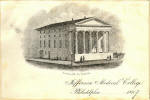
Medical
School label from the inside cover of the above text
A full reproduction of the 1861 version in
pfd format:
http://jdc.jefferson.edu/milsurgusa/8/
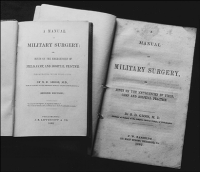
Northern and Southern Civil War
editions of Samuel D. Gross's Manual of Military
Surgery
Samuel David Gross was born
in Easton, Pennsylvania, on 8 July 1805. He married Louisa Weissell in 1828;
they had at least four children, including physician Samuel Weissell Gross
(1837-1889). Gross died in Philadelphia on 6 May 1884. Gross received his
M.D. from Jefferson Medical College in 1828. He first practiced in
Philadelphia, then removed to Easton. In 1833, Gross became Demonstrator of
Anatomy at the Medical College of Ohio, then Professor of Pathological
Anatomy at the Cincinnati Medical College. From 1840 to 1856, Gross was
Professor of Surgery at the University of Kentucky in Louisville. In 1856,
he succeeded Thomas D. Mutter in the chair of surgery at Jefferson Medical
College and held that post until 1882. Gross was president of the American
Medical Association in 1867 and president of the International Medical
Congress in 1876. He became an Associate Fellow of the College of Physicians
of Philadelphia in 1846 and a full Fellow in 1857.
When the U.S. Civil War began, Gross
produced A Manual of Military Surgery (1861), with a pirated Confederate
version appearing in Richmond in 1862.
GROSS, Samuel David, surgeon, born near Easton, Pennsylvania, 8 July, 1805; died
in Philadelphia, 6 May, 1884. He studied medicine, was graduated at Jefferson
medical college in 1828, and began practice in Philadelphia, employing his
leisure in translating medical works from the French. He settled in Easton in
1829, in 1833 was appointed demonstrator of anatomy in the Medical college of
Ohio, at Cincinnati, and in 1835 professor of pathological anatomy in the same
institution. Here he delivered the first systematic course of lectures on morbid
anatomy ever given in the United States. Five years later he became professor of
surgery in the University of Louisville, Kentucky, and in 1850 succeeded Dr.
Mort in the University of New York. By request of his associates, he returned to
Kentucky and resumed work there, after only a single session in New York. He was
one of the founders and early presidents of the Kentucky state medical society.
While in Louisville he published an elaborate "Report on Kentucky Surgery"
(1851), including a biography of Dr. Ephraim McDowell, of Danville, in that
state, in support of the claims that he was the originator of ovariotomy in
1809. In 1856 he was chosen professor of surgery in Jefferson medical college,
Philadelphia, which post he occupied until within two years of his death, when
he resigned on account of advancing years and desire for repose. He founded with
Dr. T. G. Richardson in 1856 the "Louisville Medical Review," a bimonthly, of
which only six numbers were issued. They afterward established in Philadelphia
the "North American Medico-Chirurgical Review," which continued to appear till
the civil war. Shortly after settling in Philadelphia he founded, with Dr. Da
Costa, the Philadelphia pathological society, of which he was the first
president.
In 1862 Dr. Gross was made a member of the
Royal medical society of Vienna. In 1867 he was elected president of the
American medical association, and in 1868 a member of the Royal
medico-chirurgical society of London, and of the British medical association. In
1872, during his second visit to Europe, the University of Oxford, at its one
thousandth commemoration, conferred on him the honorary degree of D. C. L.; and
that of LL. D. was given him by the University of Cambridge. He was a member of
numerous medical and surgical associations at home and abroad, and was
unanimously elected president of the International medical congress which met in
Philadelphia in September, 1876. Dr. Gross made many original contributions to
surgery. In 1833 he made experiments on rabbits, with a view to throwing light
on manual strangulation, which are described in Beck's "Medical Jurisprudence."
He was the first to suggest the suturing of divided nerves and tendons, wiring
the ends of bones in certain dislocations, laparotomy in rupture of the bladder,
and many other operations, and was the inventor of numerous instruments,
including a tourniquet, an instrument for extracting foreign bodies from the ear
or nose, and an apparatus for the transfusion of blood. His original
investigations were varied, though often carried on with insufficient means and
amid adverse surroundings. He began in early life to contribute to medical
literature, edited the "American Medical Biography" (1861); and published
"Diseases and Injuries of the Bones and Joints" (Philadelphia, 1830); "Elements
of Pathological Anatomy" (2 vols., 1839; 3d ed., 1857); "Wounds of the
Intestines" (1843); "Diseases, Injuries, and Malformations of the Urinary
Organs" (1851; enlarged eds., 1855 and 1876); "Results of Surgical Operations in
Malignant Diseases" (1853); "Foreign Bodies in the Air Passages" (1854); "Report
on the Causes which Retard the Progress of American Medical Literature" (1856);
"System of Surgery" (2 vols., 1859; 6th ed., with alterations, 1882);
"Manual of Military Surgery" (1861; Japanese
translation, Tokio, 1874); "John Hunter and his Pupils" (1861); "History of
American Medical Literature," two lectures (1875); and with others "Century of
American Medicine" (1876).
Edited Appletons Encyclopedia, Copyright © 2001 VirtualologyTM
Samuel David Gross
One of six children, Gross was born to Philip and Johanna Juliana (Brown) Gross
on July 8, 1805, on a farm outside Easton, Pennsylvania. Growing up in the heart
of Pennsylvania Dutch country, Gross spoke German until the age of 12, and even
after he learned English, his dialect retained a distinct German accent. His
father was a farmer who died when Gross was nine years old. After that, his
mother raised him, instilling strong moral values that stemmed from her devout
Lutheran faith. As a child Gross spent a good deal of his time outdoors. He was
very attentive to nature, studying the calls of birds, the habits of the local
animals, and the indigenous plant life.
Gross received his early education at country schools. At 17, he decided to
begin his studies in medicine. As was the custom of the time, he was paired with
a practicing physician, Joseph K. Swift. From Dr. Swift he learned basic medical
skills such as how to make pills, apply plaster casts, and bleed patients. He
also assisted in surgical procedures and in childbirth. In his spare time he
would study subjects such as anatomy as best he could. Feeling he needed more
formal education, Gross abandoned his apprenticeship with Swift to enroll in
school in Wilkes-Barre, Pennsylvania. He completed his general educational
requirements at the highly regarded Academy in Lawrenceville, New Jersey.
In 1824 Gross returned to work once again with Swift in local practice. He
planned to attend medical school at the University of Pennsylvania. But before
he could do so, Gross was accepted as a private student of Dr. George McClellan,
the father of the Civil War General George B. McClellan.
In 1828 Gross received his medical degree from Jefferson Medical College in
Philadelphia, a school McClellan founded in 1825. His thesis was "The Nature and
Treatment of Cataract." In the same year that he graduated he married Louisa Ann
Weissell, a 20-year-old widow with one child. They would have six children of
their own.
Translations and Original Works
After getting his degree, Gross remained in Philadelphia. He continued to work
with McClellan and opened his own medical practice on Library Street, near Fifth
Street. Business was slow during the first months of his practice. With few
patients to see, Gross worked on translating French and German medical works
into English. The translations he published included A Manual of General Anatomy
(1828) by A.L.J. Bayle and H.L.G.M. Holland, A Manual of Practical Obstetrics
(1828) by Jules Hatin, and A Treatise on the Nature, Cause, and Treatment of
Contagious Typhus (1829) by V.J. von Hildenbrand. His most important and
well-received translation was Elements of Operative Surgery (1829) by Alphonse
Tavernier, the first treatise on surgical medicine published in the United
States.
Believing that the United States needed its own body of medical literature,
Gross stopped translating foreign texts and began to write original works. His
first book, Treatise on the Anatomy, Physiology, and Diseases and Injuries of
the Bones and Joints, was published in the fall of 1830. Although highly
regarded by the medical profession, the book produced no income for Gross, who
was still struggling to make ends meet.
To make more money, Gross in late 1830 moved his practice back to Easton, where
he became more successful. He conducted important experiments on dogs regarding
gunshot wounds in the abdomen. C.J. Parkes of Chicago later used his works. His
similar experiments gained a wide audience. In 1832 Gross was chosen by the
Easton Town Council to travel to New York to study Asiatic cholera, a disease
recently introduced to the United States.
Elements of Pathological Anatomy
In 1833, with the recommendation of Dr. John Eberle, a former professor at
Jefferson Medical College, Gross was appointed demonstrator of anatomy at the
Medical College of Ohio. When Daniel Drake founded the Cincinnati Medical
College two years later, Gross secured a position as a professor of pathological
anatomy and chair of the department. There, based on a series of lectures, he
created the first systematic study of morbid anatomy in the United States.
In 1839 Gross published his landmark work, Elements of Pathological Anatomy. It
was the first time information on pathological anatomy was presented in a
complete, systematic form. Primarily due to the book's great length, Gross had
difficulty getting a publisher. It was published only after many rejections.
Although the work was extremely popular and sold many copies, Gross received no
profits from the sales of the first edition. Nonetheless, its publication earned
him acclaim worldwide, and he became the most celebrated doctor in the United
States. Elements of Pathological Anatomy was issued in several editions, and it
remained the leading reference in its field for over 25 years.
When the Cincinnati Medical School closed in 1839, Gross accepted a position as
the chair of the surgical department at the Louisville Medical Institute, later
known as the University of Louisville. He remained in Louisville until 1850,
then went to New York to take over the chair in surgery at the University of the
City of New York. The following year he returned to Louisville. In 1856 he
became professor of surgery at his alma mater, Jefferson Medical College, where
he remained until the end of his life.
Other Influential Works
Over the course of his long career, Gross published numerous works that
substantially influenced the development of a systematic theory and practice of
medicine in the United States. In 1843 he published Wounds of the Intestines, an
exhaustive clinical study based on animal research, again the first book of its
kind to be published in the United States. In 1851 he gained recognition for his
contribution to urology with his book A Practical Treatise on the Diseases and
Injuries of the Urinary Bladder, the Prostate Gland, and the Urethra. The book
was subsequently accepted as the primary authority in the field of urology. Two
more editions, in 1855 and 1876, followed. His son, Samuel Gross, edited the
latter. The book described the surgical method of cutting into the bladder to
remove a calculus, an innovative procedure for which Gross gained even more
attention. Gross was widely recognized for his skills as a surgeon, and people
traveled long distances to have Gross perform bladder surgery on them.
In 1854 Gross published A Practical Treatise on Foreign Bodies in the
Air-Passages. Again, Gross offered the first systematic approach to this medical
procedure in the United States. The work served as the chief source in the field
until the development of the bronchoscope, which allowed for more in-depth
observation.
Gross published yet another highly influential work in 1859. His two-volume A
System of Surgery: Pathological, Diagnostic, Therapeutic and Operative, went
through six editions from 1859 to 1882. The first edition consisted of 2,360
pages and 936 illustrations; the last edition included 2,300 pages and 1,600
illustrations. In the Dictionary of American Biography, J. Chalmers Da Costa
refers to the work as "the greatest surgical treatise of the day, and probably
one of the greatest ever written." Da Costa describes it as "a veritable mine of
information" and noted that it "gives evidence of the broadest scholarship and
the most complete acquaintance with surgical literature, a philosopher's grasp
of all surgical problems, and an immense clinical experience." Translated into
numerous languages, the book was an immense success.
When the U.S. Civil War began, Gross produced A Manual of Military Surgery
(1861), with a pirated Confederate version appearing in Richmond in 1862. Also
in 1861, Gross edited a hefty edition of Lives of the Eminent American
Physicians and Surgeons of the Nineteenth Century, and in 1868 he issued Memoir
of Valentine Mott, a renowned American surgeon. In honor of the U.S. centennial,
Gross published A History of American Medical Literature from 1776 to the
Present Time (1876) and A History of American Surgery From 1776 to 1876, each
important for its historical and bibliographical value. He also published John
Hunter and His Pupils (1881), a biography of another medical pioneer.
Published posthumously, the Autobiography of Samuel D. Gross, M.D., with
Sketches of His Contemporaries (1887) was edited by his sons and serves as a
valuable history of 19th-century medicine. Along with his books, Gross conducted
surgical clinics, addressed medical societies, and participated in medical
debates. He also served as an editor for several medical journals, including the
North American Medico-Chirurgical Review and the Louisville Medical Review,
which he founded with T.G. Richardson in 1856.
Achieved Great Acclaim
The renowned doctor was immortalized in American culture as the subject of
Philadelphia artist Thomas Eakins's painting, originally known as "The Portrait
of Professor Gross." Eakins began his work in 1875, hoping to capture Gross in
the midst of his surgical brilliance. The painting, which became a national icon
of the times, is now known as "The Gross Clinic." It was first displayed at the
Philadelphia Centennial Exhibition in 1876 and subsequently purchased by the
Jefferson Alumni Association two years later.
Gross was one of the founders of the American Medical Association and served as
its president in 1867. He was also the first president of the Philadelphia
Pathological Society, vice-president of the German Surgical Society, and a
member of the Philadelphia Academy of Surgery and the American Surgical Society.
In 1876 he led the International Congress of Surgeons, held in Philadelphia. He
also established a prize for original medical scholarship. Given every five
years, the award was sponsored by the Academy of Surgery and became known as the
Samuel D. Gross Prize. Gross held numerous honorary degrees from academic
institutions around the world, including Oxford University, Cambridge
University, the University of Edinburgh, and the University of Pennsylvania.
Active as a teacher and surgeon until the very end of his life, Gross died in
Philadelphia on May 6, 1884. Just days before his death, he operated on a
patient to remove a stone from the bladder. Although medical research has
advanced tremendously since his day, Gross is still considered one of the
greatest surgeons and one of the most important advocates for the advance of
medicine.
Books
American National Biography, Volume 9, edited by John A. Garraty and Mark C.
Carnes, Oxford University Press, 1999.
Biographical Dictionary of American Educators, Volume 2, edited by John F. Ohles,
Greenwood Press, 1978.
Encyclopedia of American Biography, 2nd edition, edited by John A. Garraty and
Jerome L. Sternstein, HarperCollins, 1995.
Online
"Samuel David Gross," Dictionary of American Biography,http://www.galenet.com(January
18, 2001).
"Gross, Samuel David," Merriam-Webster's Biographical Dictionary,http://www.galenet.com(January
18, 2001).
|



